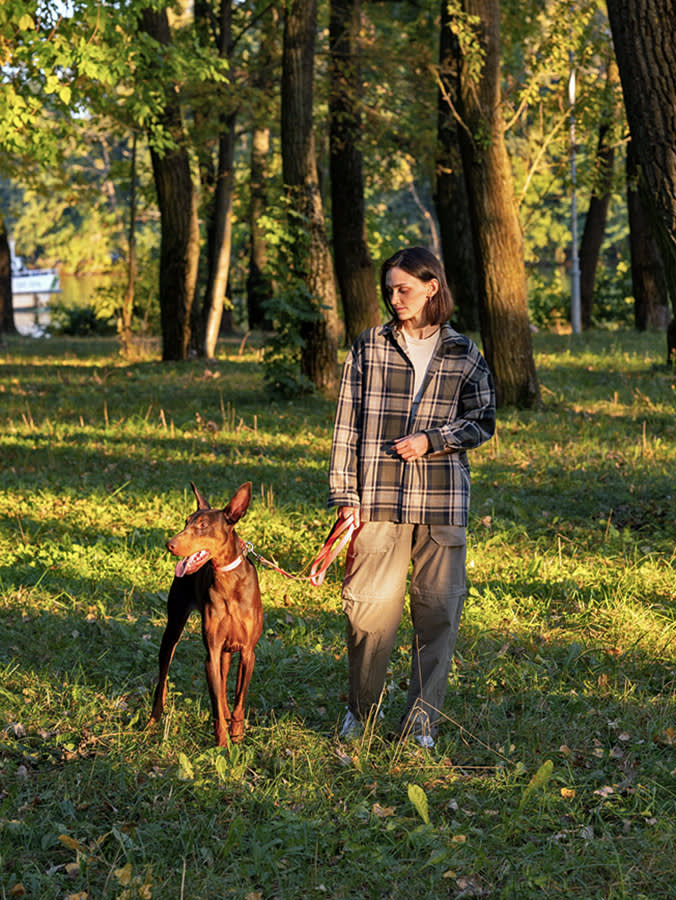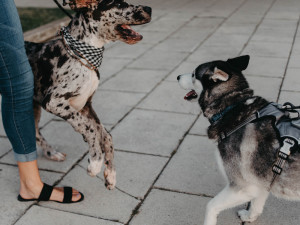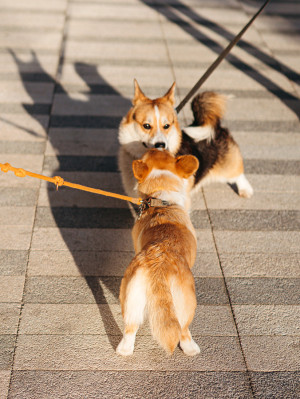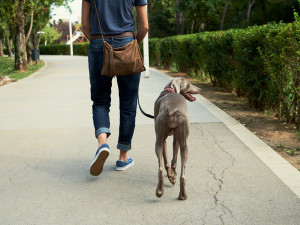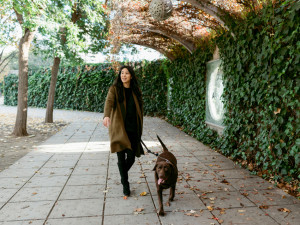4 Places You Can Walk a Reactive Dog Without Stressing Them Out
If your dog jumps at the sight of cars and cowers in front of kids, consider these safe, relaxing spots.
In an ideal world, dog walks are a pleasant way to unwind — for you and your pup. You see some sights, they smell some smells, and everyone comes home happy. But where should you walk a reactive dog who flinches at the mere sight of a stroller, barks at strangers, or cowers in the face of cars?
Life with a jumpy dog is no less rewarding, but these harried hounds have different needs than their more easygoing counterparts. As pet parents, we owe it to them to make their walks feel as safe and rewarding as possible, and that starts with the location.
Trick question: All dogs are perfect! But find out which type is the best fit for you.
What do you say, do you wanna go outside? We asked certified behaviorist Melissa Simpsonopens in new tab, owner and head trainer at Happy Tails Dog Training LLCopens in new tab in Grand Rapids, Michigan, and Stephanie Bargeropens in new tab, dog trainer and owner of Canine Zenopens in new tab, which offers remote dog training throughout the United States, to help us scout out the best places to give reactive dogs some fresh air.
“Walking and/or exercising reactive dogs can be challenging,” Simpson says. “Step one is understanding what triggers your dog’s reactivity: people, other dogs, loud noises, sudden movements, or a combination of things. Step two is choosing situations to set your dog up for a low stress walk.”
How much do you spend on your pet per year?
Where should you walk a reactive dog?
Anywhere away from their triggers
Every dog is going to have their own preferences. Some dogs are fine around people but terrified of other dogs. Some can’t stand loud noises. Others freak out around crowds of kidsopens in new tab. Before you start scoping out locations, make a list of your dog’s biggest triggers so that you know what to avoid.
Per Simpson, triggers may include but are not limited to other dogs, unfamiliar people, prey animals (like squirrels), birds, and cats, and movement from vehicles or pedestrians.
“No single example will work for every dog,” Barger says. “The key is to determine what triggers your dog's unwanted behavior and pick places where you are less likely to encounter them.”
Once you’ve made a list of triggers and brainstormed promising places accordingly, scout them first without your dog to get the lay of the land. Once you’ve found a good spot, bring your dog (plus lots of treats) and take things slowly. Here are some suggestions for places you can go:
1. Peaceful parks
For dogs who are afraid of vehicles and city sounds, a park could be an ideal place for a walk. Still, not all parks are created equal. Simpson recommends looking for spaces that feature “clear and open lines of sight during low activity times of the day, with plenty of space to step off the walking path and provide your dog the opportunity to focus on you and/or search for treats on the ground while distractions pass.”
Whenever you’re outside with your dog, make sure that your contact information is up to date on both their microchip and their tags. Even if your dog is chipped, it’s crucial that they wear ID because not everyone who finds a lost dog will know to have their microchip checked.
2. Private spaces
If you want to make sure you and your dog will have room to yourselves, consider using Sniffspot to rent a private outdoor space opens in new tab for your dog to run around and train. Simpson also recommends checking with locally owned pet-friendly shops and privately owned dog parks. “Many are offering times you can sign up to bring your dog shopping or to the park when it is just you and your dog for a specified period,” she says.
3. Open fields
Much like a clear park, a wide, barrier-free field will allow your dog to see what’s coming in all directions while playing and exercising, Simpson says. For dogs that get anxious when they can’t gauge all possible threats, this could provide a feeling of extra security.
4. Your backyard
If you happen to have an outdoor space of your own, and especially one that’s fenced, why not help your dog take advantage of it by turning it into a doggie theme park? Simpson suggests setting up find-it gamesopens in new tab and obstacle courses, playing hide and seek, and teaching your dog new tricks.
How do you plan for walks with a reactive dog?
This will depend on your dog’s specific triggers. For most dogs, however, consider planning your outing for a quiet, low-traffic hour when triggers will be less frequent.
Simpson recommends checking out the location before you go to ensure it’ll provide a positive experience. “Whether your dog is overly excited, nervous, or fearful, the fewer stimuli, the easier it is for your dog to enjoy the time outside if there are less distractions,” she says.
Simpson also recommends bringing along a few positive reinforcements like treats and treasured toys. Finally, she says, make sure that you yourself bring a positive attitude and are ready to support your dog as they explore a new place.
Where should you not walk a reactive dog?
Just like every reactive dog’s preferred walking places will vary, so, too, will the list of spots to avoid. That said, there are some common factors to consider.
“Usually, very loud and busy locations are difficult for dogs,” Barger says. “However, any place where your dog's triggers are present will put your dog on edge and you will want to avoid them unless you are working a behavior modification program to help them feel better about their triggers.”
Similarly, Simpson suggests avoiding high-traffic areas like city sidewalks and parks, pet stores, dog parks, bus stops, playgrounds, crowded parks and trails, or fairgrounds. As tempting as dog-friendly restaurants and bars might be, they’re likely not a great place for a reactive poochopens in new tab, either. Same goes for gatherings with lots of unfamiliar people — even at your own home.
Ultimately, our experts’ general advice is the same: stay away from anywhere your dog exhibits discomfort.
What are signs that your dog is scared on a walk?
Any time you’re out with your dog, it’s crucial to monitor their behavior and body language to make sure they’re feeling secure and content. If you notice subtle or overt signs of stress, it might be time to call it a day and gently guide your dog home.
“Your dog can display signs of discomfort before they overreact which gives you a chance to change the situation so that you don't get the unwanted behavior,” Barger says.
Some signs of anxiety will be obvious: pulling on the leash, lunging, barking, growling, snarling, shaking, cowering, et cetera. Others will be quieter. Watch how your dog holds their ears, tail, and head, their mouth movements and breathing patterns, and their relative body tension or relaxation.
According to Simpson, some signs of discomfort could include yawning when not tired, head dipping, turning the head away, squinty eyes, large pupils, changes in tail position, mouth open versus closed, ears forward versus back, and quick flicks of the tongue.
“If you are concerned your dog may be fearful on a walk, it may help to have someone video your dog’s body language so you can watch it after your walk to look for these more subtle changes in your dog,” Simpson says. From there, you can “assess what was happening around your dog at the time, and that will provide a start as to what your dog is fearful about on your walks.”
Whatever you do, Simpson says, if your dog is showing signs of reactivity, it’s worth considering professional help.
“Dogs do not ‘outgrow’ these behavior issues,” she says. “While not every reactive dog will learn to enjoy a dog park or dog friendly restaurant, a good behavior trainer will help you and your dog learn the best possible way to keep your dog happy and in a good emotional state.”
